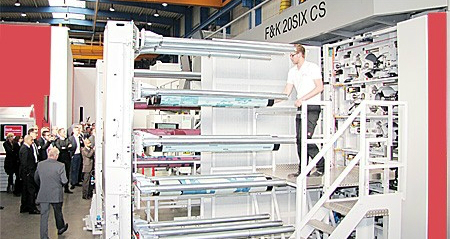First shown as a discussion area at drupa 2008, the full PrintCity project is now beginning with the objective of studying the issues and opportunities involved in ultra-high web offset press productivity from web widths up to 2850mm. As is the normal practice in PrintCity Alliance research projects, the whole process value chain will be analysed, with all pros and cons assessed.
PrintCity says as a result the increasing numbers iof heatset printers considering moving to ultra-high output heatset printing will have much of the guidance required – benefits, investment advice, consumables and operational information – in one location. Additionally, PrintCity Alliance team members who work on this project are there to jointly advise on specific customer needs across the entire production process.
These new ultra-wide commercial web presses will allow production of up to 96 pages long grain or short grain. The first manroland Lithoman 96-page short grain press will shortly be installed at Mohn Media, Gütersloh, Germany.
The move to Ultra Wide Web Offset presses is driven by ultra-high productivity, beneficial investment economics, high automation possibilities plus lower energy consumption potential advantages. This project seeks to bring wider market understanding of the opportunities and the issues involved – presses, consumables, prepress and postpress.
The 96-page press format follows the successful, proven, 80-page 2250mm presses already installed. The whole process knowledge value chain, available from PrintCity Alliance members working together, has been important to make these steps forward.
Primary advantages of such ultra wide presses and their consumables are:
- Lower cost per copy than presses of a smaller format – consumables, labour and press costs
- Lower total investment than multiple presses of a smaller format – for an equal pagination output
- Lower total energy consumption for a given high pagination production output – versus smaller format presses of the same total output
Additionally there are advantages versus traditional publication gravure presses, where the time and costs of offset plate preparation are much lower than for preparing gravure cylinders.
PrintCity Ultra Wide Web Offset project team members are: Lüscher, manroland, Megtec, Muller Martini, Sun Chemical, Trelleborg, and UPM.
In addition PrintCity says that as it is clear that there is an increasing level of convergence between newspapers and magazines PrintCity in 2009 is planning the expansion of its focus areas into value added printing of magazines, to better understand the marketing and technical issues.
This study will use the proven approach of VAPoN (value added printing on newspapers) combined with experience from the 2008 PrintCity PRINTplusX project, which seeks to assess the secrets of value added printing. Further announcements will be made in 2009 with the expectation that such a project will publish a report in the 2010 time period.
Comment below to have your say on this story.
If you have a news story or tip-off, get in touch at editorial@sprinter.com.au.
Sign up to the Sprinter newsletter

